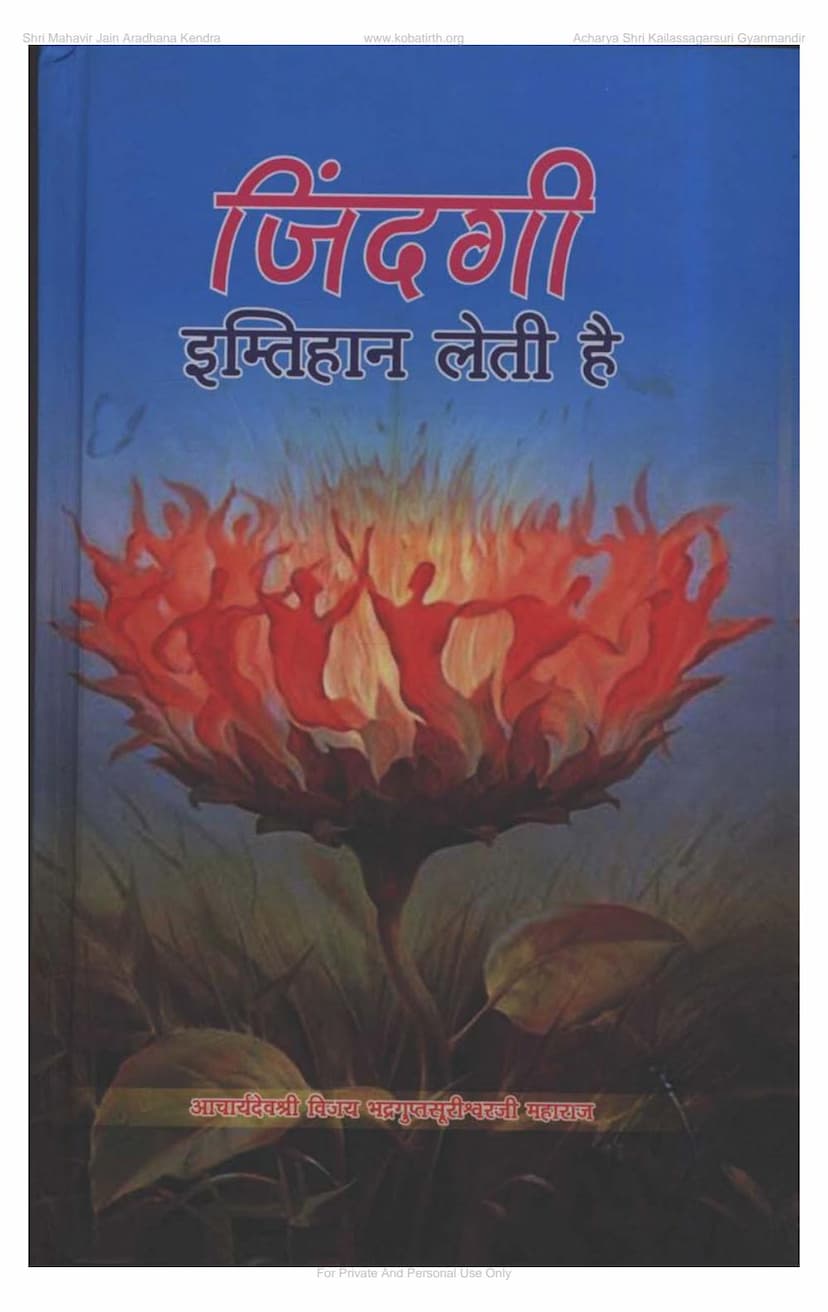Jindgi Imtihan Leti Hai
Added to library: September 2, 2025

Summary
Here's a comprehensive summary of the Jain text "Jindgi Imtihan Leti Hai" (Life Tests Us) by Bhadraguptasuri (also referred to as Shri Priyadarshan), based on the provided pages:
Book Title: जिंदगी इम्तिहान लेती है (Jindgi Imtihan Leti Hai - Life Tests Us) Author: Shri Priyadarshan (Acharya Shri Vijay Bhadraguptasuri Ishwarji Maharaj) Publisher: Shri Mahavir Jain Aradhana Kendra, Koba Compilation: The book is a collection of 72 inspirational letters.
Core Theme: The central message of the book revolves around the trials and tribulations of life and how to navigate them with spiritual wisdom, equanimity, and adherence to Jain principles. The author, Acharya Shri Vijay Bhadraguptasuri, through his letters, guides the reader to understand that life is a constant examination, and true spiritual progress lies in facing these tests with courage, understanding, and detachment.
Key Principles and Advice from the Letters:
- Perspective and Vision: Many letters emphasize the importance of changing one's perspective (दृष्टि बदल दे - change your vision). The author encourages readers to look beyond superficial appearances and understand the underlying reality. For instance, seeing parents as "selfish" is a flawed vision; instead, one should recognize their contributions and show gratitude.
- The Nature of Happiness: True happiness doesn't come from accumulating pleasures but from sharing and spreading happiness. The pursuit of fleeting pleasures leads to suffering, while selfless giving brings lasting joy.
- Relationships and Family: The book delves into the complexities of family relationships, addressing conflicts arising from differing viewpoints. The author advises understanding, tolerance, and sacrificing personal desires for the greater good of loved ones. He highlights the unconditional love of a mother and the importance of valuing it.
- The Role of Karma and Destiny: While acknowledging the influence of karma (पुण्य के आधीन है - is dependent on one's good karma), the author stresses that one's actions and qualities (गुण) are crucial in shaping their destiny and in their ability to offer happiness to others.
- Dealing with Adversity: Life is filled with challenges, like deserts with thorns rather than flowers. The author advises against succumbing to despair when faced with difficulties. Instead, one should cultivate inner strength, patience, and equanimity.
- The Importance of Self-Realization: The core of spiritual growth lies in understanding oneself ("आत्मानं विद्धि" - Know thyself). Without self-knowledge, true solutions to life's problems remain elusive.
- Love and Devotion: The author distinguishes between worldly attachments (राग, मोह, वासना) and true, selfless love (प्रेम). True love is unconditional, growing, and doesn't seek personal gain. He emphasizes the need for love towards all beings, not just a select few, and encourages the pursuit of divine love through devotion and meditation.
- The Nature of 'Prem' (Love): Several letters extensively discuss the essence of true love, drawing from Jain scriptures and philosophical insights. True love is described as:
- Nirupadhik (without conditions or desires): Not seeking anything in return.
- Nirgun (without attachment to qualities): Loving someone irrespective of their virtues or faults.
- Pratiksahan Vardhmana (constantly growing): Ever-increasing and expanding.
- Avichhinna (unbroken and continuous): Uninterrupted and everlasting.
- Sukshmatara (subtle): Deep and subtle, beyond superficial perception.
- Anubhav-roopa (experiential): Felt and realized, not just intellectual.
- Detachment and Non-Attachment (Vairagya and Anasakti): The author strongly advocates for detachment from worldly possessions, relationships, and even the sense of self. This detachment is not about being cold or unfeeling but about maintaining inner freedom and equanimity amidst life's experiences. He stresses that true Vairagya brings a deeper, more profound joy than worldly attachments.
- The Value of the Present Moment: Dwelling on past regrets or future anxieties diminishes the present. The author encourages living mindfully in the present, cherishing what one has, and not being swayed by the impermanence of worldly experiences.
- The Role of Faith and Surrender: Trusting in the divine (Parmatma) and surrendering to His will is presented as a path to inner peace and strength. This surrender is not passive but an active acceptance of life's flow.
- The Importance of Right Vision (Samyak Darshan): Cultivating a balanced and truthful perspective is crucial. This involves understanding the true nature of reality, the impermanence of the world, and the eternal nature of the soul.
- Discipline and Effort: While emphasizing faith and surrender, the author also stresses the importance of personal effort, self-discipline, and consistent practice (sadhana) in spiritual growth.
- Critique of Superficial Spirituality: The author gently critiques practices that are merely outward show or driven by personal desires (e.g., praying for material gain, seeking praise). True spirituality comes from the heart and is demonstrated through consistent inner transformation.
- The Purpose of Life: The ultimate goal is self-realization, liberation (Moksha), and experiencing the eternal bliss of the soul. Life is presented as a journey of spiritual learning and self-improvement.
Overall Tone and Style: The letters are written in a compassionate, wise, and encouraging tone. Acharya Shri Priyadarshan uses simple yet profound language, often drawing from relatable examples and anecdotes to illustrate his points. The advice is practical, encouraging introspection and behavioral change, all within the framework of Jain philosophy and ethics.
Significance: The book aims to provide spiritual solace and practical guidance to individuals navigating the challenges of daily life, offering a path towards inner peace, resilience, and spiritual fulfillment. It serves as a reminder that life, with its tests, is an opportunity for growth and self-discovery.